In an organization with a data-driven culture, employees immediately and instinctively turn to data to inform their decision-making. This culture is especially important for modern teams that operate in complex, rapidly changing environments.
Building an evidence-based attitude takes effort, but artificial intelligence (AI) can accelerate development. AI tools make data collection and analysis easier and faster, enabling team members at every level to use information in new ways.
AI tools improve decision-making by rapidly analyzing vast datasets and extracting relevant insights. These tools also enhance team performance and the use of concrete intelligence in every area of work.
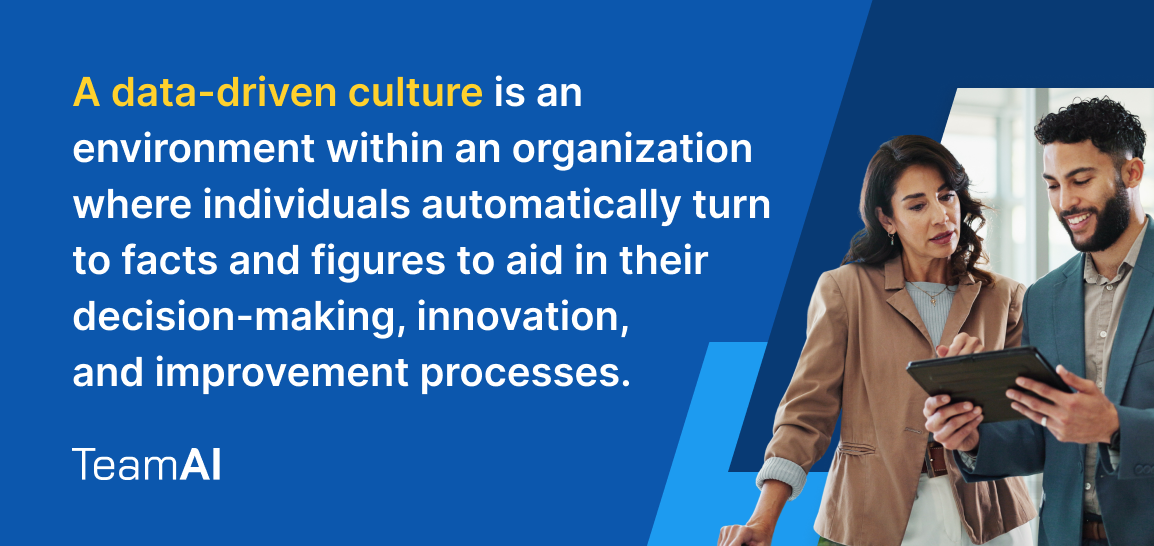
What is a data-driven culture?
A data-driven culture is an environment within an organization where individuals automatically turn to facts and figures to aid in their decision-making, innovation, and improvement processes.
Essentially, this culture aims for more frequent and effective data use. This environment involves more than simply following numbers. It requires critical thinking and interpretation skills.
Building this culture demands underlying structures and policies, including access, governance guidelines, and analytical practices. An organization must also have technologies that store, analyze, and share information. AI often serves these roles and helps develop the desired culture.
Benefits of a data-driven culture
Building a mindset focused on data throughout an organization brings many benefits, including:
- Improved decision-making: Instead of relying on instincts or guesses to inform decisions, businesses use evidence as a solid foundation.
- Increased efficiency: Effective data usage enables team members to make faster decisions. Reports also help uncover performance issues to improve workflows.
- Better alignment: Information provides a common language that speaks to individuals across departments. It helps with aligning goals and making strategic decisions.
- Advanced innovation: Unlocking insights from collected information empowers companies to understand their customers and find new opportunities.
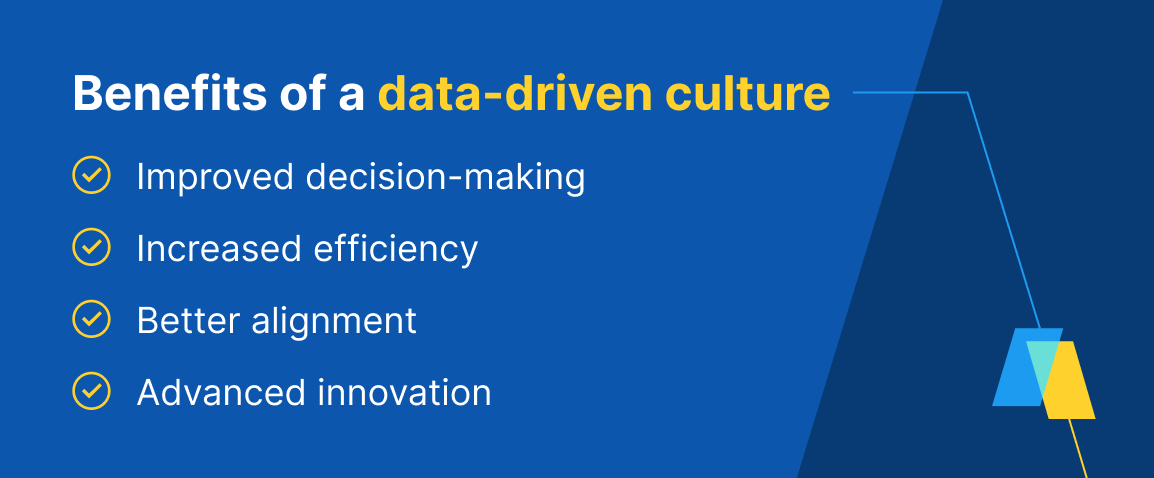
Why use data over intuition?
While intuition may seem to be the secret to success, most successful companies build on facts rather than gut feelings. Intuition has several weaknesses, especially the limitations of biases and personal experience.
Intuition also leads individuals to seek out patterns where there aren’t any or follow the patterns set by competitors. Figures provide objective evidence to follow, which guides decision-making in even the most complex situations.
The role of AI in fostering a data-driven culture
Modern businesses seeking to make decisions based on metrics often benefit from artificial intelligence. This technology automates data collection, analysis, and reporting.
AI works with vast structured and unstructured inputs to extract relevant information. Whether your documents include sales numbers or customer reviews, AI effectively analyzes them, finding patterns people might miss.
A few AI technologies that support this culture include:
- Predictive analytics: This technology uses current knowledge to predict future trends, helping businesses plan for success.
- Natural language processing (NLP): AI understands and analyzes human language. This capability facilitates the analysis of qualitative text data.
- Machine learning: Over time, AI models improve by learning from new data, making insights more relevant and useful.
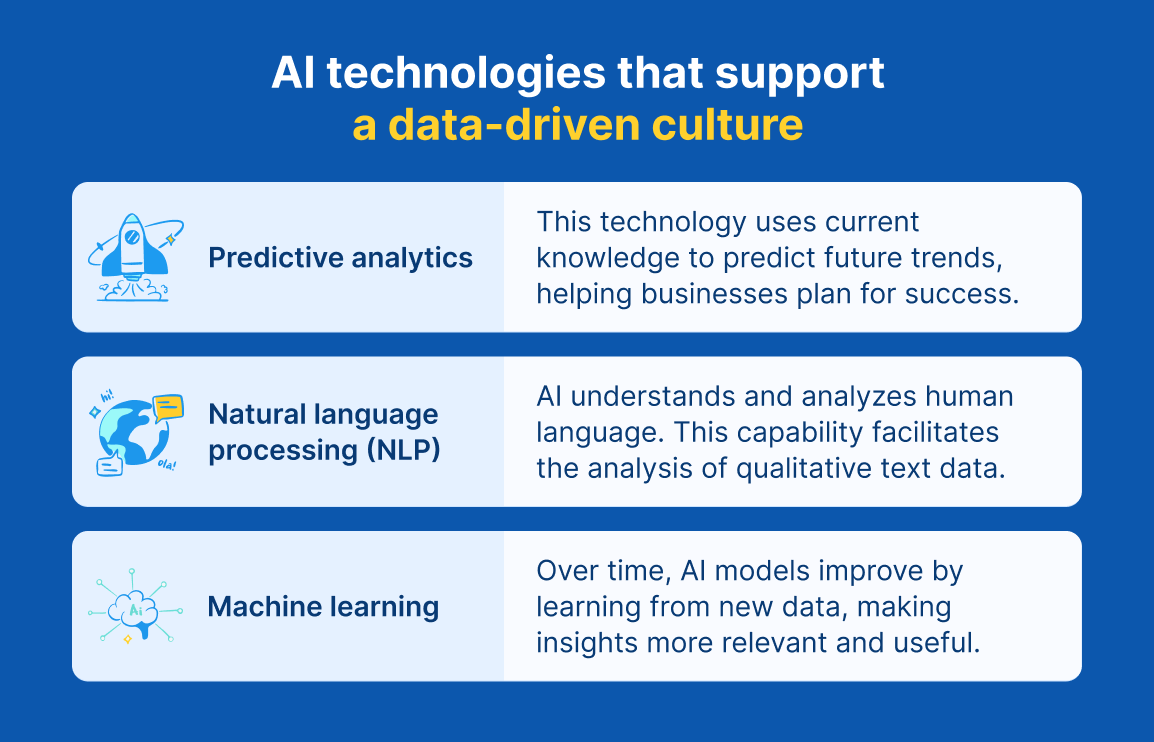
Begin fostering this environment by using an AI platform to store your data. TeamAI offers AI Data Hubs, which enable businesses to centralize data. Store thousands of documents in one place so all your information is at your fingertips.
Whenever team members need to work with data, it will be easy to find. They can then use the details to create reports or analyses.
This convenient access and usage make team members more willing to harness data. What was once a time-consuming chore takes minutes to accomplish.
Actionable tips for building a data-driven culture with AI
Every business has deeply ingrained attitudes and behaviors that take effort to adjust. However, if a company relies more on intuition than data, it can change by following several best practices and implementing AI.
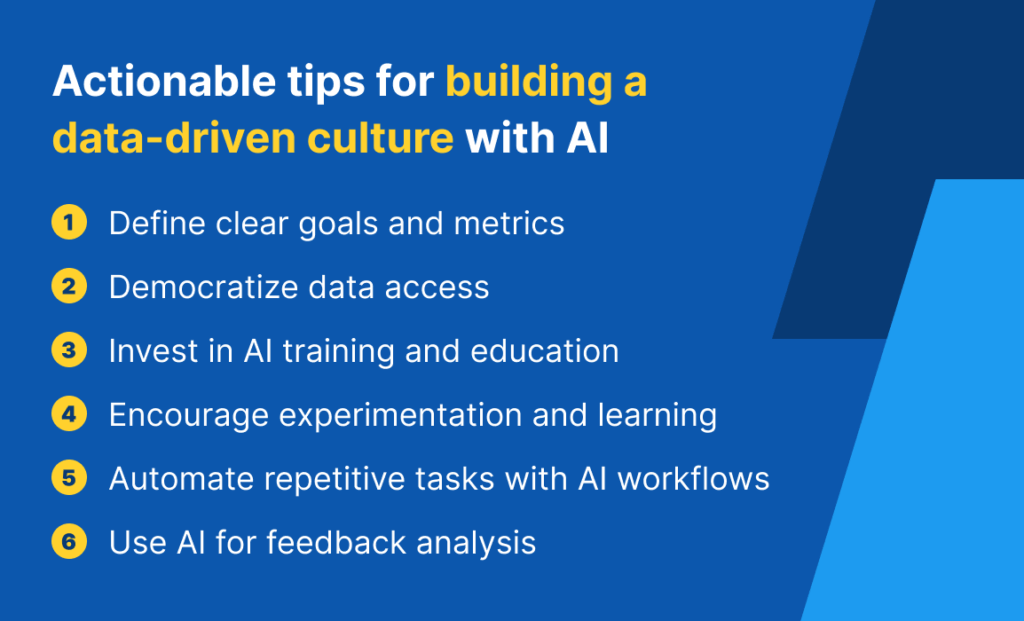
Define clear goals and metrics
Set specific, measurable, achievable, relevant, and time-bound (SMART) data and AI usage goals. These clearly defined objectives give everyone a straightforward picture of what success looks like.
During this stage, your AI task could involve creating AI-powered dashboards. These tools could help you monitor key performance indicators (KPIs) in real time. Ideally, team members at every level should have access to these dashboards.
This step makes people more engaged and excited about collecting and using information in their work. They will begin to consider data a part of their job, even if they work in a role that traditionally uses facts and figures very little.
Democratize data access
In a data-driven company culture, every team member has access to information so they can see and use it. To allow access, companies will need to break down silos. This process may involve setting governance guidelines to ensure team members handle data appropriately.
AI-powered tools democratize data by simplifying access and analysis for nontechnical users. For example, with TeamAI, anyone on a team can upload or access materials within AI Data Hubs. If they need data, they know where to go.
TeamAI helps democratize analysis by making it easier for users with minimal experience. Custom Prompt Libraries include prebuilt prompts for analyzing information and generating reports. You can also build prompts for your particular analysis tasks.
These capabilities let employees interact with files and documents more conversationally.
Invest in AI training and education
AI data analysis tools make building a data-focused mindset easier, but users must know how to employ them effectively. Give individuals the necessary background knowledge with training.
This education could start with general instruction regarding analysis and interpretation. These background skills will enable users to think critically about details and understand why they matter to their work. Training may involve:
- Books
- Webinars
- Certification courses
Once employees have a solid foundation, you can train them on AI and the tools you plan to implement. This education may involve instruction on adding materials to the AI platform and using prompts to analyze them effectively.
Part of the training involves assessing your team’s current level. If you use TeamAI, employ usage insights to see how team members currently operate the platform. These details let you explore targeted team learning opportunities.
Encourage experimentation and learning
If your business has operated the same way for a long time, employees are likely accustomed to current operations and resistant to change. A favorable attitude toward experimentation allows team members to try new things without fear.
In the context of AI, this experimentation could involve letting users interact with AI in different ways to see how these methods help them analyze data.
Organizations can promote this culture with awards or recognition for employees who try new techniques, even if unsuccessful. Ultimately, this approach helps accelerate AI adoption and uncovers new, novel uses for AI in the context of data analysis.
Automate repetitive tasks with AI workflows
Generating reports and analyzing vast datasets used to take extensive time and effort, which made it less appealing to employees. Now, with the help of AI, you can automate these tasks, saving time and making individuals more likely to use data in their everyday work.
TeamAI includes Automated Workflows, which enable individuals to turn multistep analysis processes into a single action that takes seconds or minutes to complete.
A sales team member could harness this functionality to collect lead details from their customer relationship management (CRM) software. Then they can score leads, designate them to an appropriate sales representative, and generate a summary report of qualified leads and particulars like assigned sales representatives.
In human resources (HR) and hiring, you can engage Automated Workflows to gather applicant information from resumes, applications, and LinkedIn profiles. Then, the system could analyze candidate qualifications, rank candidates, and generate a report summarizing the top candidates.
Overall, Automated Workflows build a focus on data by making it easier for team members to extract relevant insights from numerous sources.
Use AI for feedback analysis
As you employ AI to focus on data, feedback analysis can help you focus on continuous improvement. AI enables you to collect and analyze feedback from various channels to improve the experience of your teams and customers.
AI has NLP capabilities that let you assess customer reviews and identify key areas for improvement in your culture. Additionally, AI can analyze feedback from your team to impact your internal processes.
Schedule regular audits during which you review feedback from various sources. You can also adopt A/B testing to compare different AI approaches and find the best one for your needs.
Overcoming challenges
Reshaping an organizational culture takes time. Along the way, you may run into roadblocks, but there are various solutions to keep moving forward.
Data Silos
To use data effectively, teams must have access. Silos keep the information contained within a department where other teams can’t access it.
The solution involves finding a centralized location for storing data, such as AI Data Hubs in TeamAI. Before doing this, consider any sensitive information you may need to conceal, and create detailed governance guidelines. Breaking down silos may also include educating employees on the advantages of sharing data.
Skills gaps
In a culture historically driven by intuition, team members may lack the knowledge to fully utilize data. Training bridges these gaps. AI makes analysis easier for those without prior experience, allowing teams to interact with data more easily.
Change resistance
Employees may have grown used to a certain mode of operation. Once they are comfortable, they may hesitate to change their approach. A few ways to deal with change resistance include:
- Encouraging experimentation
- Communicating about the benefits of a data-driven culture
- Providing incentives for using data and AI
- Using leadership support to convince others to get on board
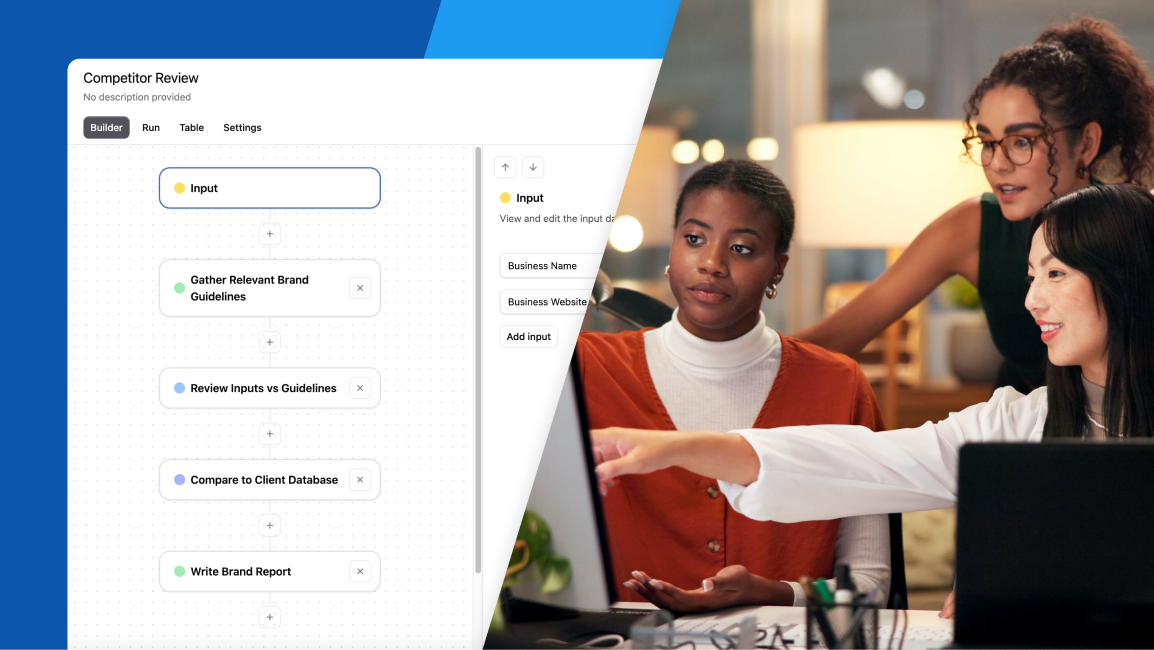
Leverage AI for data-driven decision-making
A data-driven culture provides a solid foundation for an organization’s decision-making process, and AI can help achieve it by making data more accessible and easier to analyze.
Start building this mindset within your business by using TeamAI. Create a workspace to leverage key features like AI Data Hubs, Automated Workflows, and Custom Prompt Libraries. TeamAI also includes features like Data Analysis, enabling you to extract key insights from CSV files.
Sign up online today to experience the benefits of TeamAI for data analysis and reporting.
